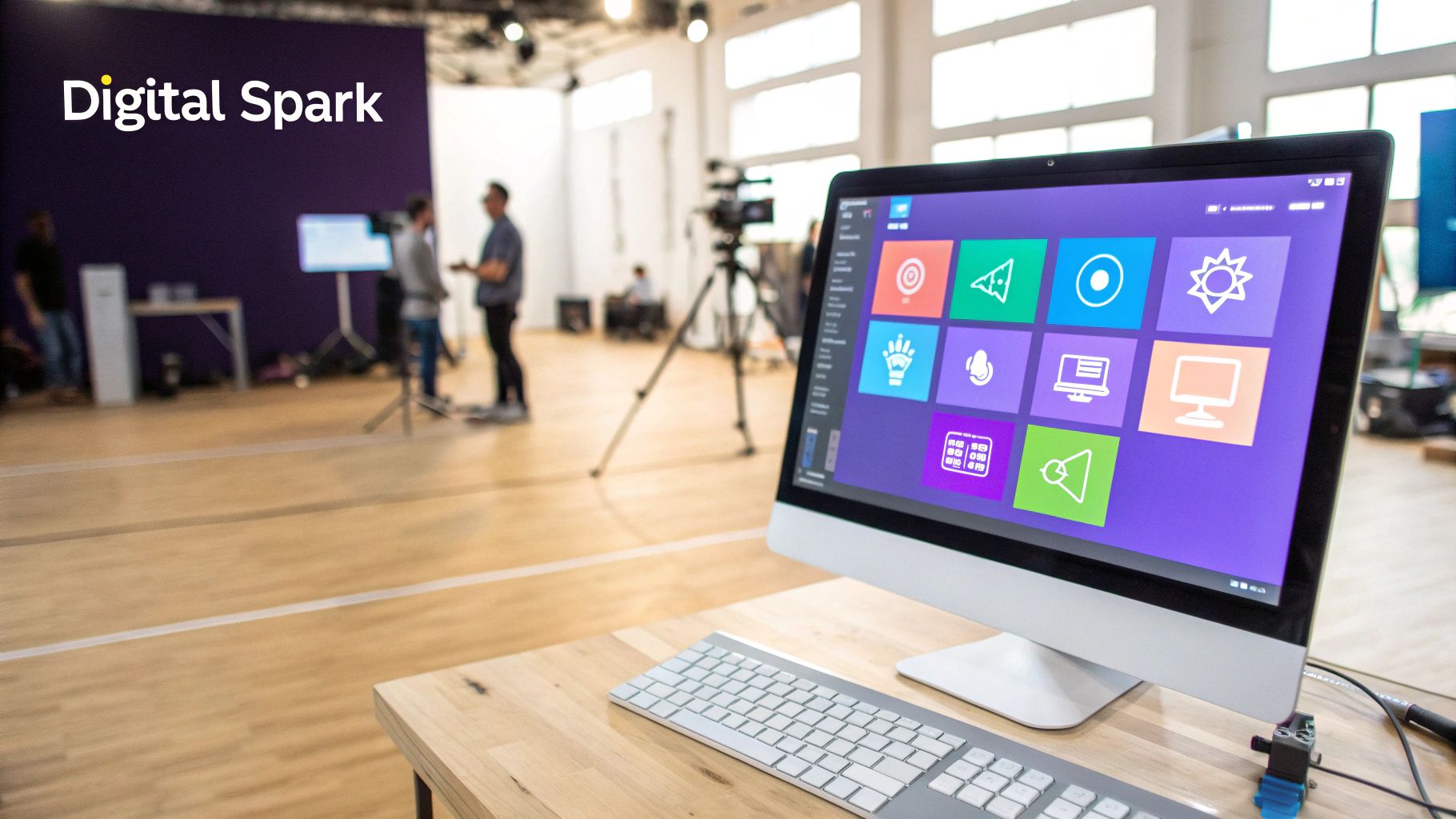The Evolution of Innovation in Remote Environments

The way we work has dramatically changed. This shift has impacted how we innovate, accelerating it in many cases rather than hindering it. Remote work has challenged traditional collaboration and ushered in a new era of creativity in virtual spaces. Several factors drive this evolution, including the rapid adoption of digital tools and the rise of flexible work models.
The widespread use of virtual collaboration platforms has broken down geographical barriers, enabling seamless communication between team members. This allows real-time idea sharing and project management, regardless of location. Flexible work arrangements also empower individuals to work during their most productive hours, leading to a more focused and creative mindset.
This allows teams to tap into global talent pools and work asynchronously. The result is a continuous cycle of innovation.
The rapid shift to remote work has also significantly shortened digital transformation timelines. Implementations that once took years now happen in months. Innovation in remote teams has accelerated considerably since the start of the COVID-19 pandemic.
A McKinsey survey found that companies accelerated digitization efforts by an average of three years. This led to new business formations, patents, and venture capital investments. In 2021 alone, 5.38 million applications were filed for new U.S. businesses, a 50% increase over 2019's pre-pandemic levels. Find more detailed statistics here: How Virtual Work Is Accelerating Innovation. This accelerated digitization presents unprecedented opportunities for innovation within distributed teams.
Reimagining Creative Processes for Remote Teams
This new era also requires a rethinking of traditional innovation practices. Many companies find old methods don't translate effectively to virtual work. For instance, brainstorming sessions, a staple of in-person teams, can become unproductive in a virtual setting. You might be interested in: How to master remote innovation strategies. This requires new frameworks and approaches designed specifically for remote collaboration.
Understanding how to scale a business in a remote setting is crucial. Learn more with these tactics on Scaling Your Remote SaaS Business. Fostering remote team innovation requires a deliberate, strategic approach, acknowledging the unique challenges and opportunities of virtual environments. It’s about creating new ways of working that use the strengths of distributed teams, not simply replicating in-person processes. This evolution is ongoing, with organizations constantly experimenting and adapting to unlock their remote workforce's full innovative potential.
Finding the Sweet Spot Between Virtual and In-Person Ideation

When it comes to remote work, not all innovation activities are created equal. Some flourish in the virtual world, while others truly shine with face-to-face interaction. The key to successful innovation in remote teams lies in finding the right balance. Leading organizations are strategically selecting the optimal environment for each stage of their innovation process. This helps maximize creativity and minimize roadblocks.
Virtual Strengths: Gathering Diverse Perspectives and Technical Development
Some activities are naturally well-suited to the remote environment. For example, gathering diverse perspectives is often simpler when team members are geographically dispersed. Virtual tools like Zoom allow for asynchronous contributions, giving everyone time to reflect and ensuring all voices are heard. This is particularly helpful for introverted team members who might be less inclined to speak up in traditional brainstorming sessions.
Technical development, especially tasks requiring focused individual work, also often progresses more smoothly in a remote setting, away from office distractions. This allows team members to concentrate and produce high-quality work.
In-Person Power: Conceptual Brainstorming and Prototype Testing
Other activities benefit from the energy and spontaneity of in-person interactions. Conceptual brainstorming often generates more creative ideas through real-time discussions and the organic exchange of thoughts. This means the critical initial stages of innovation may benefit from in-person gatherings.
Prototype testing and other hands-on activities are generally easier to conduct and assess when the team is physically together. While remote work has become widespread, research suggests that in-person teams tend to produce more disruptive innovations. A study examining research papers and patents found that teams located in the same city generated more groundbreaking ideas than geographically dispersed teams. Explore this topic further: Remote Work & Disruptive Research.
To help illustrate the differences, let's take a look at the following table:
Innovation Activities: Remote vs. In-Person Effectiveness
| Innovation Activity | Remote Effectiveness | In-Person Effectiveness | Best Practice Recommendation |
|---|---|---|---|
| Brainstorming | Moderate – Can be challenging to replicate the spontaneity of in-person sessions | High – Fosters dynamic idea generation and collaboration | Consider short, focused in-person sessions for key brainstorming activities |
| Gathering Diverse Perspectives | High – Easier to include geographically dispersed participants and allows for asynchronous contributions | Moderate – Can be limited by logistical constraints | Leverage virtual tools to maximize inclusion and gather diverse insights |
| Technical Development | High – Allows for focused individual work with fewer distractions | Moderate – Potential for more interruptions and distractions | Encourage dedicated remote work time for technical tasks |
| Prototype Testing | Moderate – Can be challenging to coordinate and evaluate remotely | High – Facilitates hands-on interaction and real-time feedback | Prioritize in-person sessions for prototype testing and refinement |
This table highlights the strengths and weaknesses of each approach, suggesting a need for a blended strategy.
The Hybrid Approach: Blending Virtual and In-Person for Optimal Results
Many successful remote teams are embracing a hybrid approach, combining virtual and in-person interactions to cultivate innovation. This often involves bringing teams together for intensive brainstorming sessions or workshops centered around key project milestones. At the same time, they utilize virtual tools like Slack for ongoing communication, collaboration, and focused individual work.
For example, a team might hold initial brainstorming sessions in person, then transition to virtual platforms like Bulby for refining ideas and developing action plans. Bulby's structured approach can help remote teams stay focused and productive, bridging the gap between in-person energy and the efficiency of virtual work.
Mapping Your Innovation Process
Strategically considering which activities thrive in which environment is vital for fostering innovation in remote teams. By carefully mapping your innovation process and capitalizing on the strengths of both virtual and in-person collaboration, you can unlock the full creative power of your distributed team. This empowers your team to harness the best of both worlds, driving innovative solutions while maintaining the flexibility and advantages of remote work.
Unlocking Global Talent for Competitive Innovation Edge

One of the biggest advantages of remote work is access to a global talent pool. This opens doors to diverse perspectives and valuable expertise, significantly enhancing a team's creative output. Forward-thinking organizations are now building multinational teams, leveraging global insights to solve complex problems. This allows them to move beyond the limitations of a local talent pool.
This shift towards global talent acquisition is fueled by the rise of remote work. From 2005 to 2019, remote work grew by a staggering 216%. At the peak of the COVID-19 pandemic, 69% of the US workforce worked from home. Even in 2023, 30% of US employees continue to work remotely – six times higher than pre-pandemic levels. This widespread adoption has greatly expanded the innovation potential of distributed teams. For a deeper dive into these trends, check out these Remote Work Statistics.
Managing Innovation Across Time Zones
Managing innovation across different time zones requires strategic planning. "Follow-the-sun" development, for example, allows continuous project progress. Tasks are handed off to team members in different time zones as the workday progresses, maximizing productivity and minimizing downtime. Asynchronous communication tools are also essential. Platforms like Bulby help bridge geographical and temporal divides with structured communication and efficient workflow management.
The Power of Cultural Diversity in Innovation
Cultural diversity is a powerful driver of innovation. Teams with diverse cultural backgrounds bring a wider range of perspectives and problem-solving approaches. This leads to more creative and effective solutions that might be missed by homogeneous teams. For instance, a team with members from both individualistic and collectivist cultures could approach a marketing challenge with both individual creativity and a focus on group harmony, resulting in a more nuanced and effective campaign.
Recruiting and Onboarding Global Innovators
Attracting and integrating innovation-minded talent globally requires tailored recruitment and onboarding processes. This means actively searching for individuals with proven creativity and problem-solving skills, regardless of location. Effective onboarding is also crucial for integrating new remote team members into the company culture and ensuring they feel valued and supported.
Inclusive Practices for Remote Innovation
Finally, fostering innovation in remote teams requires an inclusive environment. Every team member should feel comfortable contributing their ideas, regardless of location, language, or cultural background. This might involve using translation tools, providing cross-cultural training, and establishing clear communication protocols that encourage open dialogue and respectful interaction. By creating a truly inclusive environment, organizations can unlock the full potential of their global talent and drive significant innovation.
Building a Virtual Culture Where Bold Ideas Flourish

Creating the right virtual culture is key for remote teams to truly innovate. This means fostering psychological safety, where everyone feels comfortable sharing their ideas – even the unusual ones – without fear of being judged. When team members feel valued, they're more likely to take chances and explore new possibilities. This foundation of trust is essential for innovation in a virtual environment.
Establishing Psychological Safety in Virtual Environments
Building trust and open communication should be a top priority for successful remote teams. Regular virtual check-ins, transparent decision-making, and dedicated spaces for informal interaction can all help achieve this. For instance, a dedicated Slack channel for non-work conversations can build camaraderie and a sense of belonging. Leaders also play a vital role by actively encouraging feedback and demonstrating a genuine willingness to listen and respond to suggestions. This creates shared ownership and empowers everyone to contribute to innovative efforts.
Facilitating Virtual Ideation Sessions
Effective virtual brainstorming requires more than just video calls. Using interactive tools like virtual whiteboards and collaborative brainstorming platforms can greatly enhance creative output. These tools enable real-time idea generation and visualization, engaging all team members, regardless of their personality. Furthermore, structured brainstorming exercises and clear guidelines keep the discussion focused and productive, ensuring inclusivity and efficiency. This structured approach helps maximize the value of virtual brainstorming. You might be interested in: How to master creative problem-solving techniques for breakthrough innovation.
Innovation-Focused Rituals for Remote Teams
Just like in-person teams, remote teams thrive on rituals and routines. Creating innovation-focused rituals like virtual hackathons, asynchronous brainstorming sessions, and dedicated "innovation time blocks" can cultivate a culture of continuous creativity. Virtual hackathons provide a focused environment for generating new ideas and developing prototypes. Asynchronous brainstorming, using tools like Bulby, lets team members share ideas at their own pace, offering maximum flexibility and inclusivity. Setting aside specific times solely for innovative thinking encourages team members to prioritize creative exploration.
Recognizing and Celebrating Innovation in Remote Teams
Recognizing both successes and valuable failures is crucial for ongoing improvement. Effective recognition should celebrate breakthroughs while acknowledging the lessons learned from experiments that didn't quite work out. This encourages risk-taking and creates a safe environment for trying new things. For example, holding a "lessons learned" session after each project, highlighting both positive outcomes and areas for improvement, can be very valuable. Celebrating wins and valuable failures allows remote teams to push boundaries and drive meaningful innovation.
Leveraging Technology To Transform Remote Innovation
The right digital tools can significantly boost a remote team's creativity. Technology plays a key role in fostering innovation. Think collaborative whiteboards that unlock visual thinking or specialized ideation platforms like Bulby that structure brainstorming sessions. Leading organizations are even integrating AI and machine learning tools to enhance human creativity and overcome remote work challenges. This helps teams work smarter, not harder.
Choosing The Right Technology For Your Team
Finding the best technology depends on factors like team dynamics, innovation goals, and current workflows. There's no single perfect solution. A small startup might benefit from a simple project management tool and a virtual whiteboard. A larger organization, however, may need a more robust platform that combines project management, ideation, and communication features.
Implementing Technology Effectively
New tools should boost productivity, not disrupt it. Phased implementation and thorough training are key to successful adoption. Start with a pilot group to test the tool and gather feedback before rolling it out company-wide. Bulby, for example, offers guided brainstorming sessions, making it easy for teams to adopt structured ideation processes. For more tips, check out our guide on virtual collaboration best practices. This careful approach minimizes disruption while improving how your team works.
Tools For Knowledge Sharing, Decision-Making, and Creative Momentum
Effective remote innovation depends on tools that encourage knowledge sharing, support collaborative decision-making, and keep creative momentum going across different time zones. These tools should also integrate seamlessly into existing workflows for a smooth transition.
-
Knowledge Sharing: Platforms like a company wiki or a shared document repository are essential for storing and accessing information.
-
Collaborative Decision-Making: Tools for voting, polling, and gathering structured feedback can really streamline decision-making.
-
Preserving Creative Momentum: Asynchronous communication tools, project management platforms, and dedicated ideation tools like Bulby help keep innovation projects moving forward, even when team members are in different time zones.
To understand the landscape of available tools, take a look at the following comparison:
Remote Innovation Technology Comparison
This table evaluates key features of popular technology tools for fostering innovation in remote teams.
| Tool Category | Key Features | Best Use Cases | Limitations | Price Range |
|---|---|---|---|---|
| Project Management | Task management, progress tracking, file sharing | Managing projects, assigning tasks, tracking deadlines | Can be complex for simple projects | Free – $50+/user/month |
| Virtual Whiteboard | Real-time collaboration, visual brainstorming, idea organization | Brainstorming, workshops, visual planning | Requires digital literacy | Free – $20+/user/month |
| Ideation Platforms (e.g., Bulby) | Structured brainstorming templates, AI-powered insights, collaborative exercises | Generating ideas, solving problems, facilitating innovation workshops | Can be too structured for free-flowing brainstorming | Varies |
| Communication Platforms | Instant messaging, video conferencing, file sharing | Team communication, meetings, quick updates | Can lead to information overload | Free – $20+/user/month |
This table offers a quick overview of how different tool categories support remote innovation. Choosing the right mix of tools is crucial for success.
Technology In Action: Examples and Case Studies
Many organizations are using technology to boost remote innovation. Some companies use virtual reality for design reviews and product demonstrations, creating a more immersive experience than traditional video conferencing. Others leverage AI-powered tools to analyze market trends and identify new product opportunities, giving their remote teams a data-driven advantage. These examples show the many ways technology can help remote teams generate and develop innovative ideas.
Bulby: Powering Remote Brainstorming
Bulby is specifically designed to enhance remote team brainstorming. It offers AI-powered guidance and uses research-backed exercises to facilitate structured sessions. This helps teams avoid cognitive biases and promotes diverse thinking, resulting in more innovative solutions. Whether for product development or tackling complex challenges, Bulby makes virtual collaboration a dynamic and productive experience.
Measuring What Matters in Remote Innovation
How do you know if your remote team's innovation efforts are truly successful? This is a key question for organizations embracing distributed work. Simply counting outputs, like the number of ideas generated, isn't enough. This section explores valuable metrics that capture the real impact of remote innovation, balancing quantitative data with qualitative insights.
Beyond Basic Output: Measuring Innovation Value
Traditional metrics like patents filed or new products launched still matter. However, they don't fully capture the complexities of remote innovation. It's important to include qualitative indicators as well. These might include:
- Idea Quality: Is the idea original, feasible, and potentially impactful?
- Implementation Success: How well do ideas translate into real-world results?
- Team Collaboration: How effectively is the remote team communicating and working together?
- Employee Engagement: How enthusiastically are team members participating in innovation activities?
These qualitative factors provide a more complete picture. They show not only what is being produced but also how well the remote team is working.
Feedback Loops for Continuous Improvement
To improve remote team collaboration, a website annotation tool can be valuable. Regular feedback is essential for refining your innovation process. This means consistently evaluating what's effective and what's not. Honest assessments, followed by incremental adjustments, are key. This allows your team to adapt to new challenges and opportunities. For example, if feedback indicates unproductive brainstorming sessions, trying different virtual tools or formats can help.
Conducting Remote Innovation Audits
Periodic remote innovation audits provide valuable insights. These audits involve a thorough review of your entire innovation process, helping identify strengths and weaknesses. Frameworks for these audits often include:
- Interviews with team members: Gathering individual perspectives on current practices.
- Analysis of innovation metrics: Examining quantitative and qualitative data for trends.
- Benchmarking against best practices: Comparing your team's performance to industry standards.
These audits offer a structured approach to evaluating progress and making informed decisions.
Maintaining Momentum and Preventing Virtual Burnout
Sustaining innovation requires more than just effective processes. Addressing the human element is essential. Preventing virtual burnout is crucial. This can be achieved by:
- Encouraging breaks and time off: Helping team members recharge and avoid overwork.
- Promoting work-life balance: Supporting healthy boundaries between work and personal life.
- Fostering a supportive team culture: Creating an environment where team members feel valued.
Prioritizing well-being maintains creative energy and prevents exhaustion that can hinder innovation. This focus ensures your team remains energized and engaged.
Ready to improve your remote team's brainstorming? Unlock your distributed workforce's potential with Bulby, the AI-powered brainstorming platform designed for remote teams. Experience structured sessions, overcome biases, and generate innovative solutions in a collaborative virtual environment.

